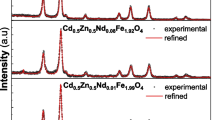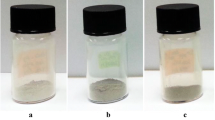Abstract
The effect of lanthanides that have positive association energies with oxygen vacancies, such as samarium and neodymium, and the elements with negative association energies, such as holmium and erbium, on ionization state of cerium and, consequentially, the oxygen vacancy concentration in doped ceria nanoparticles are investigated in this article. Structural and optical characterizations of the doped and undoped ceria nanoparticles, synthesized using chemical precipitation, are carried out using transmission electron microscopy, X-ray diffractometry, optical absorption spectroscopy, and fluorescence spectroscopy. It is deduced that the negative association energy dopants decrease the conversion of Ce+4 into Ce+3 and, hence, scavenge the oxygen vacancies, evidenced by the observed increase in the allowed direct bandgap, decrease in the integrated fluorescence intensity, and increased the size of doped nanoparticles. The opposite trends are obtained when the positive association dopants are used. It is concluded that the determining factor as to whether a lanthanide dopant in ceria acts as a generator or scavenger of oxygen vacancies in ceria nanoparticles is the sign of the association energy between the element and the oxygen vacancies. The ability to tailor the ionization state of cerium and the oxygen vacancy concentration in ceria has applications in a broad range of fields, which include catalysis, biomedicine, electronics, and environmental sensing.




Similar content being viewed by others
References
Andersson DA, Simak SI, Skorodumova NV, Abrikosov IA, Johansson B (2006) Optimization of ionic conductivity in doped ceria. Proc Natl Acad Sci USA 83:1–4. doi:10.1073/pnas.0509537103
Babu S, Velez A, Wozniak K, Szydlowska J, Seal S (2007) Electron paramagnetic study on radical scavenging properties of ceria nano-particles. Chem Phys Lett 442:405–408
Basu S, Devi PS, Maiti HS (2004) Synthesis and properties of nanocrystalline ceria powders. J Mater Res 19(11):3162–3171. doi:10.1557/JMR.2004.0442
Chen H, Chang H (2004) Homogeneous precipitation of cerium dioxide nanoparticles in alcohol/water mixed solvents. Colloid Surf A 242:61–69. doi:10.1016/j.colsurfa.2004.04.056
Chui CO, Kim H, McIntyre PC, Saraswat KC (2004) Atomic layer deposition of high-κ dielectric for germanium MOS applications—substrate surface preparation. IEEE Elect Device Lett 25(5):274–276
Das M, Patil S, Bhargava N, Kang JF, Riedel LM, Seal S, Hickman JJ (2007) Auto-catalytic ceria nanoparticles offer neuro-protection to adult rat spinal cord neurons. Biomaterials 28:1918–1925
Deshpande S, Patil S, Kuchibhatla S, Seal S (2005) Size dependency variation in lattice parameter and valency states in nanocrystalline cerium oxide. Appl Phys Lett 87:133113. doi:10.1063/1.2061873
Dhannia T, Jayalekshmi S, Kumar MCS, Rao TP, Bose AC (2009) Effect of aluminum doping and annealing on structural and optical properties of cerium oxide nanocrystals. J Phys Chem Solids 70:1443–1447. doi:10.1016/j.jpcs.2009.09.001
Dikmen S, Shuk P, Greenblatt M (1999) Hydrothermal synthesis and properties of Ce1−x La x O2 solid solutions. Solid State Ion 126:89–95
Elyassi B, Rajabbeigi N, Khodadadi A, Mohajerzadeh SS, Sahimi M (2004) An yttria-doped ceria-based oxygen sensor with solid-state reference. Orig Res Art Sens Act B 103(1):178–183
Gerhardt R, Lee WK, Nowick AS (1987) Anelastic and dielectric relaxation of scandia-doped ceria. J Phys Chem Solids 48(6):563–569. doi:0022/369718
Guo H (2007) Green and red upconversion luminescence in CeO2:Er+3 powders produced by 785 nm laser. J Solid State Chem 180:127–131. doi:10.1016/j.jssc.2006.10.003
Lawrence NJ, Jiang K, Cheung CL (2011) Formation of a porous cerium oxide membrane by anodization. Chem Commun 47:2703–2705
Nakayama M, Martin M (2009) First-principles study on defect chemistry and migration of oxide ions in ceria doped with rare-earth cations. Phys Chem Chem Phys 11:3241–3249
Oh M, Nho J, Cho S, Lee J, Sing R (2011) Polishing behaviours of ceria abrasives on silicon dioxide and silicon nitride. CMP J Powder Tech 206:239–245
Pankove J (1971) Optical processes in semiconductors. Dover Publications Inc., New York
Patsalas P, Logothetidis S, Sygellou L, Kennou S (2003) Structure-dependent electronic properties of nanocrystalline cerium oxide films. Phys Rev B 68(3):035104–035117
Qiu L, Liu F, Zhao L, Ma Y, Ya J (2006) Comparative XPS study of surface reduction for nanocrystalline and microcrystalline ceria powder. Appl Surf Sci 25:4931–4935
Shukla A, Mukherjee S, Sharma S, Agrawal V, Kishan K, Guptasarma P (2004) A novel UV laser-induced visible blue radiation from protein crystals and aggregates: scattering artifacts or fluorescence transitions of peptide electrons delocalized through hydrogen bonding. Arch Biochem Biophys 428(2):144–153
Steel B, Heinzel B (2001) Materials for fuel-cell technologies. Nature 414:345–352
Suda E, Pacaud B, Mori M (2006) Sintering characteristics, electrical conductivity and thermal properties of La-doped ceria powders. J All Comp 408:1161–1164
Trovarelli A (2005) Catalysis by ceria and related materials, 2nd edn. Imperial College Press, London
Tsunekawa S, Fukuda T, Kasuya A (2000) Blue shift in ultraviolet absorption spectra of monodisperse CeO2−x nanoparticles. J Appl Phys 87(3):1318–1321
Wei X, Pan W, Cheng L, Li B (2009) Atomistic calculation of association energy in doped ceria. Solid State Ion 180:13–17
Yamamura H, Takeda S, Kakinuma K (2007) Dielectric relaxations in the Ce1−x Nd x O2. Solid State Ion 178:1059–1064
Yin L, Wang Y, Pang G, Koltypin Y, Gedanken A (2002) Sonochemical synthesis of cerium oxide nanoparticles—effect of additives and quantum size effect. J Colloid Interface Sci 246:78–84
Zeng S, Wang L, Gong M, Chen Y (2010) Catalytic properties of Ni/ceria–yttria electrode materials for partial oxidation of methane. J Nat Gas Chem 19:509–514
Zholobak NM, Ivanov VK, Shcherbakov AB, Shaporev AS, Polezhaeva OS, Baranchikov AY, Spivak NY, Tretyakov YD (2011) UV-shielding property, photocatalytic activity and photocytotoxicity ceria colloid solutions. J Photochem Photobiol B 102:32–38
Acknowledgments
This study was funded in part by a NSF STTR Phase I grant with MW Photonics (award# 0930364). Shehata was funded through Virginia Tech Middle East and North Africa (VT-MENA) program. The authors thank Dr. Niven Monsegue, Dr. Jerry Hunter, and Andrew Giordani from the Nanotechnology Characterization and Fabrication Laboratory, Institute of Critical Technologies and Applied Science at Virginia Tech for their training and assistance with the TEM and XPS measurements. Also, the authors appreciate the support of Mr. Don Leber, manager of the Micron Technology Semiconductor Processing Laboratory at Virginia Tech.
Author information
Authors and Affiliations
Corresponding author
Rights and permissions
About this article
Cite this article
Shehata, N., Meehan, K., Hudait, M. et al. Control of oxygen vacancies and Ce+3 concentrations in doped ceria nanoparticles via the selection of lanthanide element. J Nanopart Res 14, 1173 (2012). https://doi.org/10.1007/s11051-012-1173-1
Received:
Accepted:
Published:
DOI: https://doi.org/10.1007/s11051-012-1173-1




